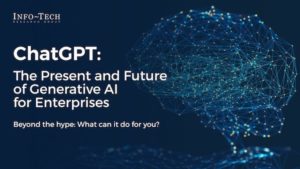
New Research Looks at the Future of ChatGPT and Generative AI in the Enterprise
TORONTO, Dec. 16, 2022 — In an increasingly digital world, conversational AI technology has become an important tool for enhancing communications and improving the user or customer experience. Most recently, ChatGPT, a large language model developed by OpenAI, is a leading example of this technology. It uses the latest advances in generative AI to deliver human-like conversations on a wide range of topics. To help technology leaders understand this technology and its potential use cases, global IT research and advisory firm Info-Tech Research Group has published its latest advisory deck, ChatGPT: The Present and Future of Generative AI for Enterprises.

Looking beyond the hype of ChatGPT and other generative AI platforms, Info-Tech’s newest research describes potential use cases for enterprises looking to implement the latest innovations. (Source: CNW Group/Info-Tech Research Group)
ChatGPT is a generative AI chatbot designed to answer questions, which is not a new concept. However, ChatGPT represents a watershed moment in the history of generative AI as it can deliver human-like conversations on diverse topics, including writing poetry, debugging code, and even assisting with troubleshooting software and hardware issues.
“OpenAI trained its ChatGPT language model using supervised learning and reinforcement learning,” says Jeremy Roberts, research director at Info-Tech Research Group. “This means that the language model was repeatedly trained by a human that demonstrates the desired behavior and then supervises the output produced by the model, reinforcing the learning by ranking outputs based on their quality.”
Unlike previous iterations of the GPT model, ChatGPT is specifically designed to serve a chatbot function. However, unlike other chatbots or intelligent software assistants, ChatGPT is much more adept at engaging in dialogue with its users and can even respond to feedback, request clarification, and iterate on its answers based on a user’s response.
“Whether ChatGPT thinks it’s a gimmick or not is irrelevant if there are no concrete use cases for the tool,” says Roberts. “Fortunately for OpenAI and others operating in this space, many generative AI use cases exist, including enterprise support, customer interactions, and even new product development.”
According to the firm’s research, some of the areas in which generative AI can help include the following:
- Enterprise Support – Despite the growth of the information economy, effective organization of information remains elusive. ChatGPT or another conversational AI tool could serve as the backend of an information concierge that automates enterprise support. Chatbots already exist, but ChatGPT could be a game-changer.
- Customer Interaction – The automated workflow of current chatbots or website search functions can frustrate users when they return a list of semi-related results. Generative AI can answer queries more cost-effectively, intelligently direct users to appropriate products and services, and improve the customer journey so substantially as to be a differentiator.
- Product Development – Content may be king, but that’s at least in part due to how difficult it can be to produce a steady stream of it. Generating marketing copy, summarizing long documents, and even authoring communications represent great business applications for generative AI. Anyone who creates content can see their workflow supplemented with an intelligent solution like ChatGPT.
“There are a few steps that IT departments should take to refine their use case for generative AI,” explains Roberts. “First, IT teams should review their capability map for high-value processes, then conduct a basic cost-benefit analysis for the technology, and finally explore the vendor landscape to find the solution that meets their requirements.”
Info-Tech’s advisory deck suggests that organizations and IT departments considering incorporating ChatGPT and other generative AI products into their service catalog follow three key recommendations:
- ChatGPT and other generative AI solutions are tools, and like any piece of software or computer hardware, there are things that this technology is especially good at and others that it is not. It’s important for technology leaders to understand the business processes and what ChatGPT is best for supporting so that they can highlight opportunities to reduce friction, increase the quality of the service experience, and drive efficiency.
- Though it may be appealing to dive right into the AI end game, IT teams should start with augmentation. Generative AI is an incredible technology, but it’s not self-sufficient. It still needs guidance and feedback from human curators, and as more processes are augmented, IT should expect to incur the cost of augmenting supervisory capabilities.
- With new frontiers come new potential problems. Chatbots that manage workflows aren’t complicated. However, a bot interacting with users and producing content could expose the organization to legal risk, perhaps by copying content from other sources or creating obscene or offensive images. Organizations should consider legal advice before implementing such technologies.
The capabilities of generative AI like ChatGPT can meaningfully reduce the manual effort in completing certain tasks. However, any function or task that requires extensive permissions and highly specific or contextual expertise could expose an organization to risks.
For more information and insights on ChatGPT and generative AI, download the complete ChatGPT: The Present and Future of Generative AI for Enterprises advisory deck.
Info-Tech Research Group is one of the world’s leading information technology research and advisory firms, proudly serving over 30,000 IT professionals. The company produces unbiased and highly relevant research to help CIOs and IT leaders make strategic, timely, and well-informed decisions. For 25 years, Info-Tech has partnered closely with IT teams to provide them with everything they need, from actionable tools to analyst guidance, ensuring they deliver measurable results for their organizations.
Source: Info-Tech Research Group






























